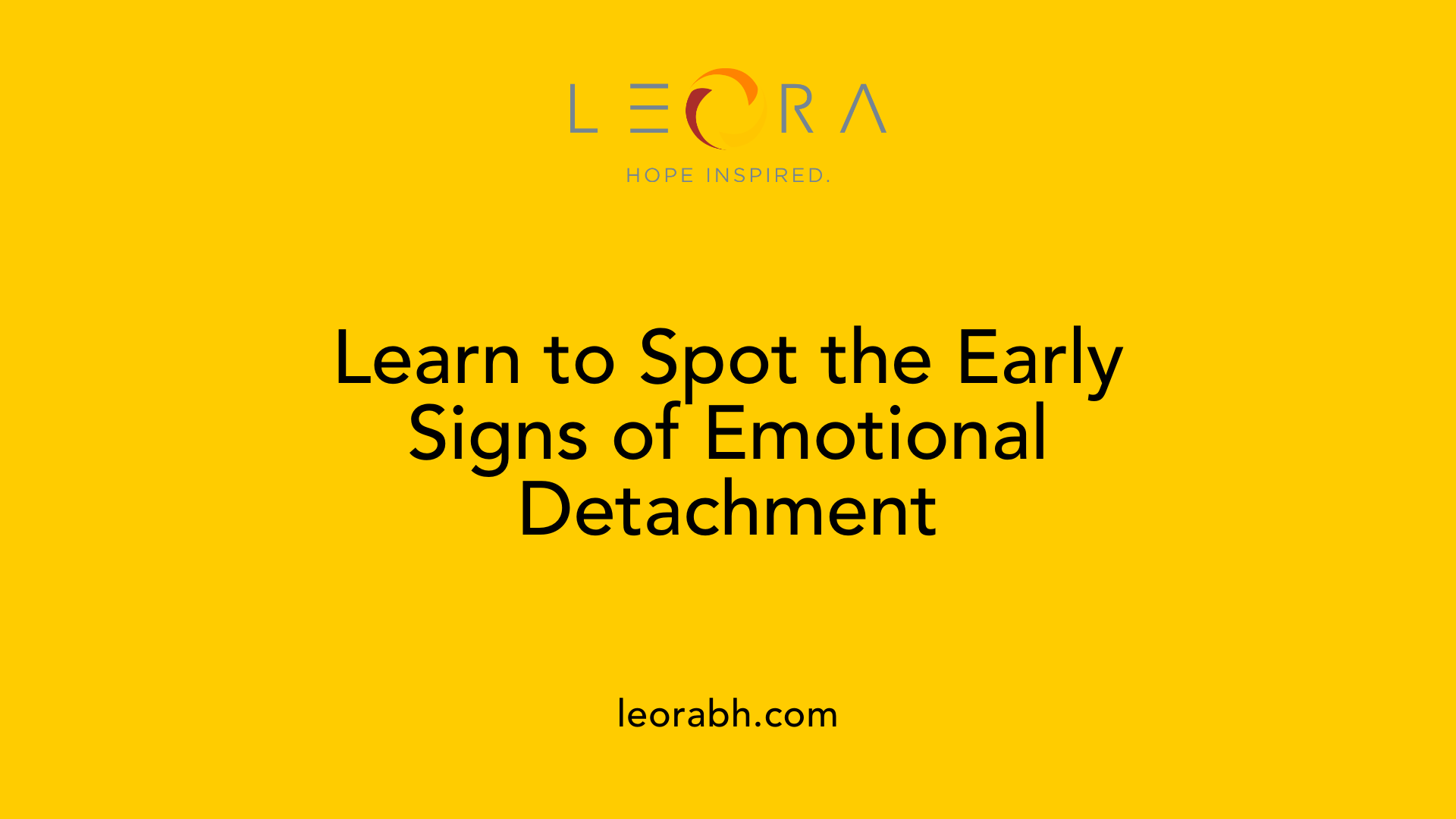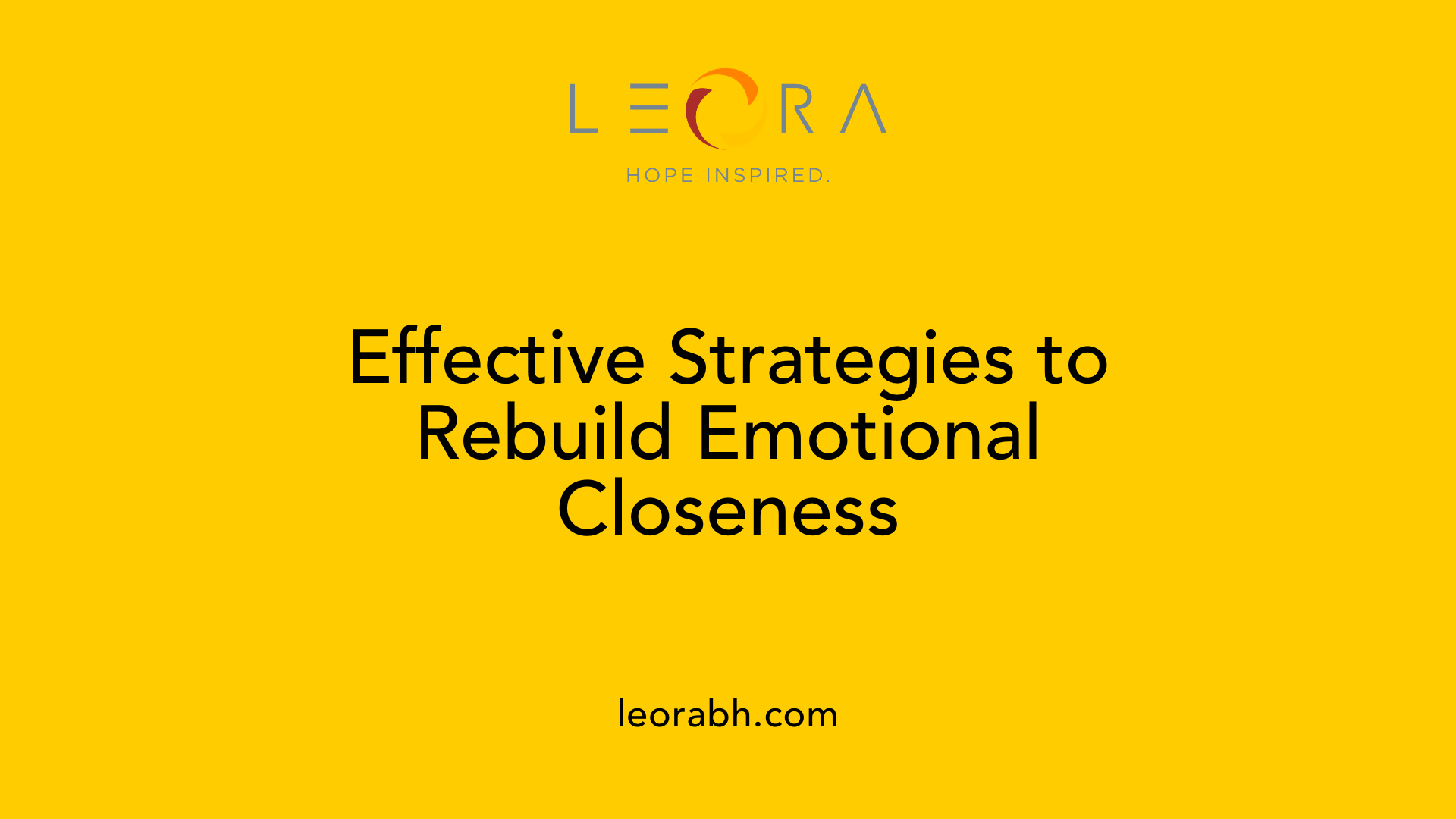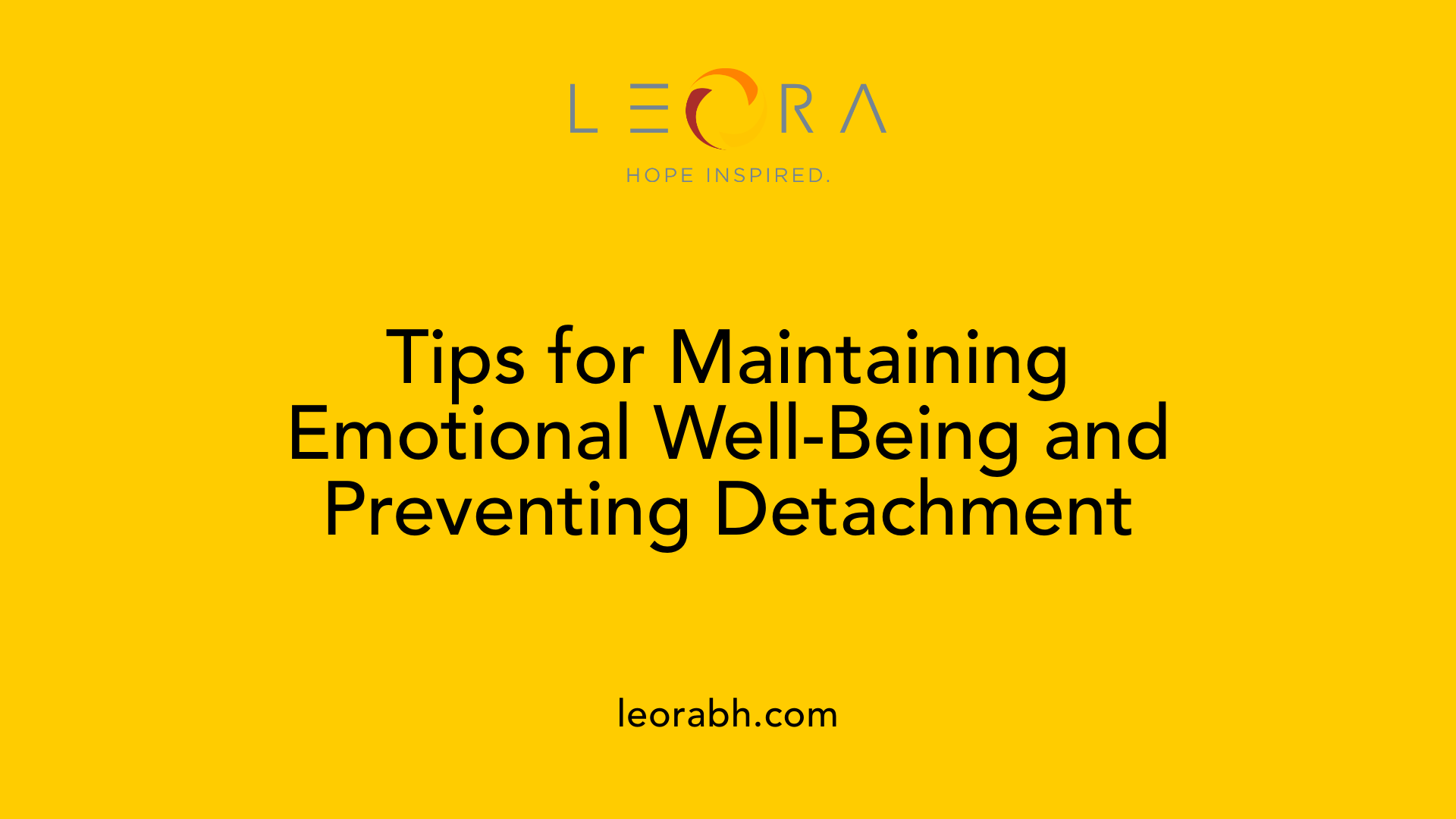Recognizing Emotional Detachment and Rebuilding Connection
Understanding and Overcoming Emotional Disconnection in Relationships
Introduction: The Hidden Chasm in Relationships
Emotional detachment can silently erode the foundation of relationships, causing partners to feel isolated, misunderstood, and distant. Recognizing signs early and understanding underlying causes are critical steps toward restoring intimacy and emotional health. This article explores the nature of emotional detachment, how to identify it, its causes, and practical strategies for rebuilding meaningful connection.
Recognizing the Signs of Emotional Detachment
 Understanding when emotional detachment occurs is essential for maintaining healthy relationships. The signs of this condition often manifest subtly over time, making early detection challenging but crucial for intervention.
Understanding when emotional detachment occurs is essential for maintaining healthy relationships. The signs of this condition often manifest subtly over time, making early detection challenging but crucial for intervention.
Signs and symptoms of emotional detachment in relationships include feeling emotionally numb or disconnected from your partner or others. You may notice a diminished ability to experience or express feelings, leading to a sense of blankness or indifference towards events that once elicited strong emotions.
Individuals experiencing emotional detachment often show less interest in activities or conversations they previously enjoyed, indicating a loss of emotional engagement. Communication might become terse, distant, or unresponsive, and you might find yourself withdrawing or disappearing without warning, especially during emotional conversations.
Reduced physical affection, emotional disengagement, and a perceived lack of kindness or empathy are also common indicators. This detachment can create a barrier to intimacy, making it difficult to connect on a deeper level.
The impact on relationships can be significant. Partners may feel unheard, unseen, or misunderstood, leading to feelings of loneliness and frustration. Over time, this emotional disconnect can strain the bond, potentially resulting in separation if not addressed.
Recognizing these behaviors early allows individuals and couples to seek support or therapy to address underlying issues. Conscious awareness and active efforts can prevent the gradual deterioration of emotional closeness and help foster renewed connection.
Understanding the Causes and Roots of Emotional Detachment

What are the causes and underlying factors of emotional detachment?
Emotional detachment often originates from past traumatic experiences such as childhood abuse, neglect, loss, or other forms of trauma. These experiences can lead individuals to develop protective mechanisms that suppress or disconnect them from their feelings to avoid pain or vulnerability.
Mental health conditions also play a significant role. Disorders like depression, PTSD, bipolar disorder, and personality disorders impair emotional engagement, making it difficult for individuals to connect deeply with others. In some cases, these conditions might cause a person to feel numb or detached from their emotions.
Certain medications, particularly some antidepressants like SSRIs, can also lead to emotional blunting. Long-term use of these drugs may diminish emotional responsiveness, contributing further to feelings of detachment.
Moreover, personal choices to emotionally distance oneself can be a strategy for managing high stress or anxiety levels, or for setting boundaries in toxic environments. These deliberate strategies, while sometimes protective, can become ingrained patterns over time.
Overall, emotional detachment typically results from a complex interplay of early adverse experiences, mental health struggles, medication effects, and individual coping choices. Recognizing these root causes is crucial for addressing and healing emotional disconnection.
Strategies for Rebuilding Emotional Connection and Intimacy

How can emotional connection and intimacy be rebuilt in a relationship?
Rebuilding emotional closeness in a romantic partnership involves intentional effort from both partners. It starts with honest and open communication. Sharing feelings, fears, and desires without judgment fosters trust and understanding.
Effective communication techniques like active listening and “I” statements help create a safe space to express emotions. Listening attentively to your partner’s perspective and validating their feelings can bridge emotional gaps.
Creating shared experiences is another powerful method. Engaging in activities together—such as date nights, hobbies, or revisiting significant memories—reinforces your bond beyond surface-level interactions. These shared moments develop trust and a sense of belonging.
Rebuilding trust also involves addressing unresolved conflicts constructively. Both partners can practice forgiveness, acknowledge mistakes, and commit to improving future interactions. Respecting each other's emotional and sexual needs is key to fostering intimacy.
Physical affection plays a vital role in emotional reconnection. Simple gestures like holding hands, hugging, or cuddling release oxytocin, the bonding hormone, and promote feelings of safety and warmth. Incorporating emotional rituals, such as daily gratitude exchanges or regular check-ins, sustains a sense of closeness.
Understanding each other’s love language can guide meaningful gestures that resonate personally. Small, consistent actions—like leaving thoughtful notes or planning surprise dates—serve as continual reminders of care and affection.
Ultimately, healing emotional intimacy takes patience, curiosity, and mutual effort. Both partners should remain committed to emotional growth, fostering an environment where vulnerability and honesty flourish. Over time, these deliberate strategies help renew trust, deepen connection, and revive the love and understanding that form the foundation of a strong relationship.
Assessing Emotional Detachment: Tests and Evaluations
 Are there any tests or assessments to measure emotional detachment?
Are there any tests or assessments to measure emotional detachment?
While there is no specific standardized clinical test solely dedicated to measuring emotional detachment, various tools can help individuals evaluate their emotional connection levels. One popular option is an online self-test consisting of around 20 questions that can be completed in roughly three minutes. This quiz assesses signs such as feeling emotionally numb, avoiding social interactions, or having difficulty empathizing with others.
These self-assessments aim to provide insight rather than official diagnoses. They often reference scientific research to support their validity, making them useful for personal awareness and initial reflection. For example, a person might find that they score high on items related to emotional disconnection, prompting further exploration.
Beyond self-tests, mental health professionals can conduct more comprehensive evaluations through psychological assessments and clinical interviews. These professional assessments help identify emotional detachment as part of broader mental health concerns, such as depression, PTSD, or personality disorders.
Interpreting results from any assessment should be done with care. A high score on a self-test, for instance, indicates a need for reflection or professional consultation but doesn't replace an official diagnosis. If you are concerned about emotional detachment, seeking support from a qualified mental health provider is the best way to obtain personalized guidance and appropriate treatment options.
Understanding how to evaluate your emotional health can be a vital step toward reconnecting or managing emotional challenges. Remember, tools like self-tests are starting points, while professional insights can offer deeper understanding and tailored strategies.
Identifying Emotional Detachment for Personal Growth and Relationships
How can I identify emotional detachment for personal growth or relationship improvement?
Recognizing emotional detachment involves paying attention to certain signs that indicate a disconnection from your feelings or those of others. Common indicators include difficulty in sharing your emotions or understanding others’ feelings, feeling numb or disconnected from your experiences, and withdrawing from close relationships. You might notice challenges in maintaining intimacy, a lack of interest in activities that once brought joy, or struggles with empathy and emotional support.
Another important aspect is observing communication patterns — if conversations tend to stay superficial or avoid deeper topics, emotional detachment could be at play. Feelings of loneliness even when surrounded by others, or a sense of being unseen and unheard, are also telltale signs.
Determining whether these feelings are temporary reactions to stress or part of an ongoing issue requires honest self-reflection and sometimes professional input. Emotional detachment can stem from coping with trauma, depression, PTSD, or other mental health conditions. It’s essential to differentiate between a temporary shield against overwhelming circumstances and a persistent pattern.
Mindfulness practices and open conversations—either with trusted friends, partners, or mental health professionals—can help clarify the origin of these feelings. Therapy or counseling offers tools to explore underlying causes, address the emotional barriers, and rebuild connections. Ultimately, recognizing emotional detachment is the first step towards fostering greater emotional awareness and strengthening relationships.
Practical Tips and Techniques for Reconnection
Managing emotional disconnection can be challenging, but incorporating small, intentional steps can lead to meaningful change. One effective strategy is to start with incremental adjustments—setting achievable goals such as sharing a feeling once a day or engaging in a gentle activity that fosters connection.
Practicing mindfulness and emotional regulation techniques plays a vital role in this process. Meditation, deep breathing exercises, and body scans help calm emotional turmoil, allowing individuals to observe their feelings without judgment. These practices enhance self-awareness, making it easier to identify emotional triggers and respond thoughtfully.
Building resilience and patience are essential as well. Reconnection doesn’t happen overnight; it requires persistence and understanding that progress may be slow at times. Celebrating small victories, like opening up slightly or reconnecting during a peaceful moment, can boost confidence and motivation.
Strengthening relationships with trusted friends and family provides a safe space for vulnerability. Sharing concerns or feelings with supportive individuals can foster validation and emotional safety. Journaling is another powerful tool—it enables reflection on personal feelings and needs, clarifying what areas require attention.
Therapy, whether individual or couples’, can address deeper issues such as past trauma or mental health challenges contributing to emotional numbness. Professional guidance helps develop personalized coping strategies and heal underlying wounds.
In practice, combining these techniques—mindfulness, relationship support, journaling, and professional help—creates a well-rounded approach to manage and reduce emotional disconnection. Patience, coupled with ongoing effort, cultivates resilience, allowing emotional engagement to grow gradually over time.
The Role of Professional Support and Therapy
Seeking help from mental health professionals can make a significant difference in overcoming emotional detachment. Couples therapy and individual counseling sessions provide a secure environment where individuals and partners can explore the roots of their disconnection. These settings encourage open dialogue about past traumas, ongoing mental health issues, and relationship patterns that may contribute to emotional distancing.
Therapies such as cognitive-behavioral therapy (CBT) and acceptance and commitment therapy (ACT) are particularly effective. They help individuals identify and change unhealthy beliefs and behaviors, fostering healthier emotional responses and greater openness. These approaches also teach mindfulness and emotional regulation techniques that can reduce feelings of numbness and increase emotional awareness.
Therapists can guide couples through communication exercises, helping them listen actively and express feelings honestly. This not only improves understanding and empathy but also helps rebuild trust and vulnerability—crucial elements for emotional reconnection.
Furthermore, professional support allows for customized treatment plans that address specific issues like depression, PTSD, attachment difficulties, or side effects from medications. By addressing these underlying conditions, therapy promotes overall emotional health and strengthens relationship bonds.
In sum, engaging with trained professionals offers structured pathways for healing emotional wounds, developing new coping skills, and fostering a deeper, more meaningful connection with oneself and one’s partner. For those struggling with prolonged detachment, counseling can be a vital component in restoring intimacy and emotional well-being.
Maintaining Emotional Health and Preventing Detachment

What can I do to maintain emotional health and prevent detachment?
Fostering emotional well-being is essential for healthy relationships and personal resilience. One effective approach is cultivating consistent self-care habits. Engage in activities that make you feel good and promote mental health, such as regular exercise, adequate sleep, and balanced nutrition.
Open and honest communication with loved ones is vital. Make a habit of daily emotional check-ins where you share your feelings and listen actively to others. Recognize and express appreciation to strengthen your bond.
Practicing mindfulness and emotional regulation skills can help you handle stress better, reducing the chances of emotional numbness or withdrawal. Techniques like meditation, deep breathing, and journaling can increase self-awareness.
Building resilience involves maintaining a supportive social life, staying physically active, and managing external stressors effectively. Setting clear personal boundaries, respecting your needs and those of others, further creates an environment of emotional safety.
Regular self-reflection on your emotional state allows early identification of detachment feelings. When needed, do not hesitate to seek professional support to address underlying issues. These proactive steps help sustain intimacy and emotional fulfillment, preventing the slide into emotional detachment.
Towards Stronger Emotional Bonds
Rebuilding and maintaining emotional connection in relationships is an ongoing journey that requires awareness, effort, and patience. Recognizing the signs of detachment, understanding its causes, and actively working to foster communication and vulnerability can restore intimacy and trust. Professional support plays a vital role in navigating complex emotional landscapes and overcoming barriers to closeness. By cultivating healthy habits, practicing mindfulness, and committing to mutual growth, partners can re-establish a deep, resilient, and fulfilling emotional bond that withstands life's challenges.
References
- 17 Signs of Emotional Detachment in Marriage and How to Fix It
- How to Identify Emotional Detachment and Overcome It
- Working Through Emotional Distance in a Relationship - Talkspace
- Emotional Detachment: What It Is and How to Overcome It - Healthline
- Rebuilding Emotional Intimacy: A Guide for Couples
- Recognizing Emotional Disconnection with Partner & How to ...
- Where emotional detachment comes from & how to reconnect - Rula
- How to Emotionally Detach from Someone: 7-Day Healing Guide
- How Do You Fix Emotional Detachment in a Relationship?
Find Your Inner Light
Related Articles
Schedule an Assessment
Leora Behavioral Health provides comprehensive treatment services, including ambulatory detox, mental health IOP, and SUD IOP, to support your journey toward lasting recovery.
Our caring team will guide you through the admissions process and create a personalized treatment plan tailored to your unique needs. We welcome walk-ins. If you or a loved one is struggling, reach out today. We’re here to help.


.svg)




.svg)
.svg)
.svg)
.svg)
